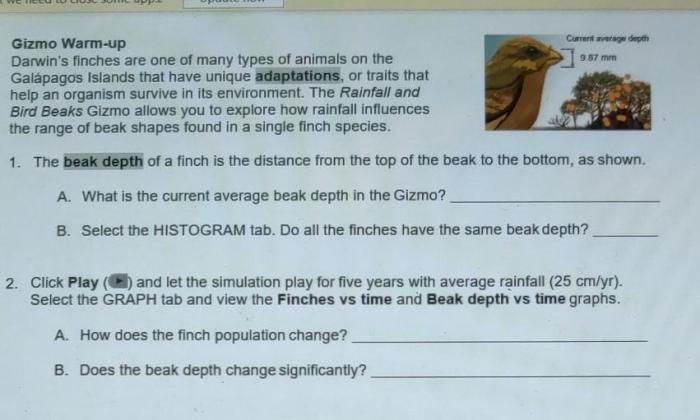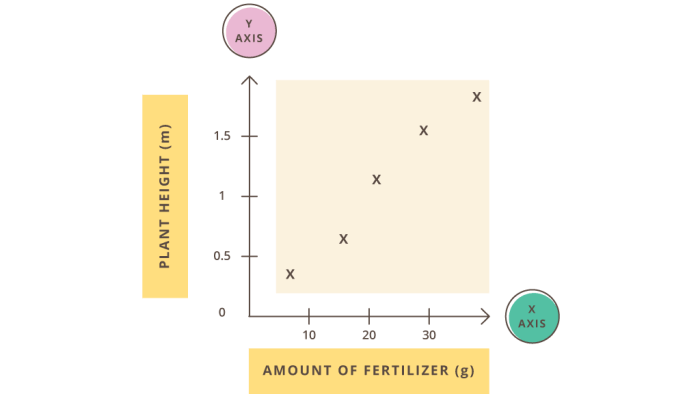Student exploration rainfall and bird beaks unveils the captivating relationship between environmental conditions and the evolution of species. By examining the impact of rainfall patterns on bird beak adaptations, this study delves into the intricate interplay between ecology and morphology, providing valuable insights into the mechanisms driving biodiversity.
This exploration engages students in hands-on activities, fostering their understanding of scientific concepts through experiential learning. Through data collection and analysis, students gain a deeper appreciation for the role of beak adaptations in bird survival and the importance of environmental factors in shaping species diversity.
Impact of Rainfall on Bird Beaks: Student Exploration Rainfall And Bird Beaks

Rainfall patterns have a significant impact on the adaptations of bird beaks. In regions with high rainfall, birds tend to have longer, more slender beaks, which are ideal for catching insects and other small prey that live in moist environments.
In contrast, birds in arid regions have shorter, stouter beaks that are better suited for cracking seeds and nuts. These adaptations provide birds with a competitive advantage in their respective habitats.For example, the Great Blue Heron, which lives in wetlands, has a long, sharp beak that it uses to spear fish and other aquatic prey.
The Arid Zone Thrush, on the other hand, which lives in deserts, has a short, strong beak that it uses to crack open seeds.
Student Exploration of Rainfall and Bird Beaks
To help students understand the relationship between rainfall and bird beak adaptations, an engaging activity can be designed. Students can collect data on the beak size and shape of different bird species in their local area and compare it to rainfall data.
They can then analyze the data to see if there is a correlation between beak size and shape and rainfall patterns.This activity can be conducted in the following steps:
- Students should choose a local area to study.
- Students should identify the different bird species in the area.
- Students should measure the beak size and shape of each bird species.
- Students should collect rainfall data for the area.
- Students should analyze the data to see if there is a correlation between beak size and shape and rainfall patterns.
Case Study: Bird Beak Adaptations in a Specific Rainforest, Student exploration rainfall and bird beaks
The Amazon rainforest is home to a wide variety of bird species, each with unique beak adaptations that have evolved in response to the local rainfall patterns. For example, the Toucan has a large, colorful beak that it uses to eat fruit, while the Harpy Eagle has a powerful, hooked beak that it uses to hunt prey.The
following table summarizes the beak characteristics, rainfall data, and ecological implications for several bird species found in the Amazon rainforest:| Bird Species | Beak Characteristics | Rainfall (mm/year) | Ecological Implications ||—|—|—|—|| Toucan | Large, colorful beak | 2,000-4,000 | Eats fruit || Harpy Eagle | Powerful, hooked beak | 1,500-2,500 | Hunts prey || Macaw | Strong, curved beak | 1,000-2,000 | Cracks nuts and seeds || Hummingbird | Long, slender beak | 500-1,000 | Feeds on nectar |
Educational Resources for Teaching about Rainfall and Bird Beaks
There are a number of online resources, videos, and interactive simulations that can be used to teach about the relationship between rainfall and bird beak adaptations. Some of these resources include:* The Cornell Lab of Ornithology’s “All About Birds” website: https://www.allaboutbirds.org/
The National Audubon Society’s “Birds and Climate Change” website
https://www.audubon.org/climate/birds-and-climate-change
The University of California Museum of Paleontology’s “Understanding Evolution” website
https://evolution.berkeley.edu/
Top FAQs
What is the significance of beak adaptations in birds?
Beak adaptations play a crucial role in bird survival by enabling them to exploit specific food sources and habitats. Different beak shapes and sizes allow birds to access a wider range of prey, from insects and seeds to fruits and nectar.
How does rainfall influence bird beak adaptations?
Rainfall patterns can influence the availability of food resources for birds, which in turn drives the evolution of beak adaptations. In areas with high rainfall, birds may have longer, more slender beaks adapted for probing flowers and extracting nectar, while in drier regions, birds may have shorter, stouter beaks for cracking seeds.
What are the educational benefits of student exploration of rainfall and bird beaks?
Student exploration of rainfall and bird beaks provides hands-on experience in scientific inquiry, fostering critical thinking, problem-solving, and data analysis skills. It also enhances their understanding of ecological concepts, such as adaptation, natural selection, and the importance of environmental factors in shaping biodiversity.


